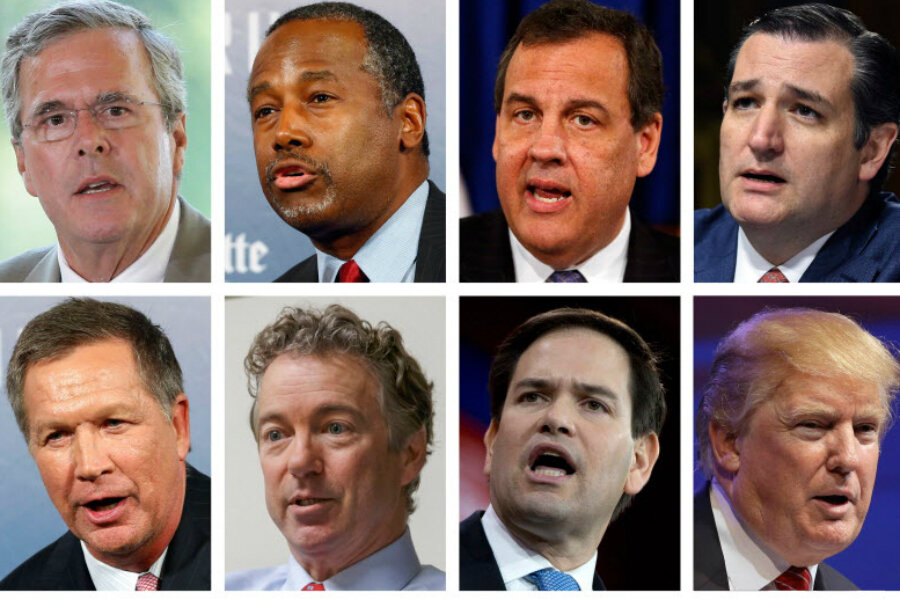Why this GOP presidential debate has a different look
Loading...
| Washington
The first televised debates on Thursday mark the launch of the 2016 presidential campaign season – and on the Republican side, it’s starting out with a field of unusual diversity, the most candidates the party has seen in 100 years.
Two Hispanic candidates, a third who speaks fluent Spanish, a black neurosurgeon with a compelling up-from-poverty story, an Indian-American governor, and a top woman executive, along with 11 others.
All those will appear in one of two debates – the main stage wouldn’t have fit them all – hosted by Fox News in Cleveland.
Democrats have long identified themselves as the big tent party, but the Republican candidates this year are a big tent all by themselves.
In short, it’s a pro-choice electoral landscape. Not that kind of pro-choice (although the GOP field even has some differences of opinion there, thanks to former New York Gov. George Pataki). We’re talking about voters’ opportunity to choose from many flavors of conservatism in Thursday's debates.
“While GOP apparatchiks are concerned about the consequences of the unprecedented size of the field of contenders, Republican voters are deliriously happy with the large and varied selection of candidates,” political analyst Charlie Cook of the Cook Political Report wrote last month. “Particularly in Iowa and New Hampshire, where party activists crave being courted, they are in heaven these days.”
In part, the field's new look is an expression of the important fight going on over the future of the party. Will the antiestablishment frustrations and far-right principles embodied in the tea party wing dominate, or will the party evolve to blend conservatism with moderation driven by demographic trends in the electorate?
This debate season won’t answer that, but it’ll put some of the tensions and fluidity of the party on display.
Donald Trump’s surprising rise in recent polls hints at the turmoil.
“In the last poll we did, we were sort of expecting to see Trump winning with far right,” but not necessarily with other Republicans, says Stefan Hankin, president of Lincoln Park Strategies, a Washington firm that does politics-related research on public opinion.
Instead, the real estate magnate led among all three basic groups broken down in the poll: people who feel their own views are to the right of the overall party, people who feel “at home” in the party, and those who lean Republican but consider their own views to the left of the party.
Mr. Trump’s appeal, rooted partly in his tapping of white-voter concern about illegal immigration, could well prove fleeting. But the poll suggests that no traditional candidate has a lock on any major segment of the primary vote, let alone an inside track to the nomination.
This flux is mirrored in the array of candidates, but the lack of a clear front-runner also plays a role.
Former Florida Gov. Jeb Bush has a surname that’s occupied the White House before, but nothing like the inevitability claimed on the Democratic side. Former Secretary of State Hillary Clinton also occupied the White House, albeit not in the top job.
Republicans also had a deep pool of potential candidates, in part because of their success winning governorships in recent years.
An influx of money hasn’t hurt, either. Big donors ready to write checks have helped embolden more candidates to jump in.
In addition to current poll front-runners Trump and Mr. Bush, the debate stage for the Fox News broadcast from Cleveland will include Wisconsin Gov. Scott Walker, former Arkansas Gov. Mike Huckabee, retired neurosurgeon Ben Carson, Texas Sen. Ted Cruz, Florida Sen. Marco Rubio, Kentucky Sen. Rand Paul, New Jersey Gov. Chris Christie, and Ohio Gov. John Kasich.
Although some of those candidates are getting narrow labels (former minister Huckabee appeals especially to Evangelical Christians, and Senator Paul to libertarians) most have at least the potential to connect with a significant share of the Republican base.
And that still leaves aside seven more candidates who didn’t make the cut (based on opinion polls) for the 9 p.m. debate: former Texas Gov. Rick Perry, former Pennsylvania Sen. Rick Santorum, Louisiana Gov. Bobby Jindal, former Hewlett Packard CEO Carly Fiorina, South Carolina Sen. Lindsey Graham, former New York Gov. George Pataki, and former Virginia Gov. Jim Gilmore.
Last time around, Mr. Santorum was the second-place finisher. This time, he’s having to start out on the “B Team.”
In part, that's a sign of the breadth of the field around him. In part, that may reflect a party ready to try out fresh faces. Senator Cruz among others is now vying for the same voters with whom Santorum connected four years ago.
As the debates move on, media attention will likely focus around a top tier who are doing well in polls and fund-raising. That puts some big pressure on those candidates expected to be in that top tier. Governor Walker hopes to eclipse Bush by rallying the party’s base. Senator Rubio wants to come off as a younger alternative to Bush (a fluent Spanish speaker) in ability to appeal from the right to the center. All of them need to start peeling support away from Trump – partly by spotlighting his flip-flops on issues like abortion.
For any of them, the path to victory runs down a difficult zig-zag path: First to capture some large chunk of a very conservative party base in the primaries – and then to position themselves for broader audience of voters in the general election.








